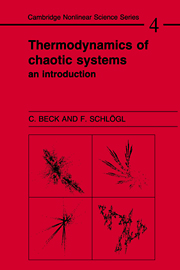Book contents
- Frontmatter
- Contents
- Preface
- Introduction
- PART I ESSENTIALS OF NONLINEAR DYNAMICS
- PART II ESSENTIALS OF INFORMATION THEORY AND THERMODYNAMICS
- PART III THERMOSTATISTICS OF MULTIFRACTALS
- 9 Escort distributions
- 10 Fractals
- 11 Multifractals
- 12 Bit-cumulants in multifractal statistics
- 13 Thermodynamics of finite volume
- PART IV DYNAMICAL ANALYSIS OF CHAOTIC SYSTEMS
- PART V ADVANCED THERMODYNAMICS
- References
- Index
11 - Multifractals
Published online by Cambridge University Press: 14 September 2009
- Frontmatter
- Contents
- Preface
- Introduction
- PART I ESSENTIALS OF NONLINEAR DYNAMICS
- PART II ESSENTIALS OF INFORMATION THEORY AND THERMODYNAMICS
- PART III THERMOSTATISTICS OF MULTIFRACTALS
- 9 Escort distributions
- 10 Fractals
- 11 Multifractals
- 12 Bit-cumulants in multifractal statistics
- 13 Thermodynamics of finite volume
- PART IV DYNAMICAL ANALYSIS OF CHAOTIC SYSTEMS
- PART V ADVANCED THERMODYNAMICS
- References
- Index
Summary
A multifractal (Benzi, Paladin, Parisi and Vulpiani 1984; Frisch and Parisi 1985; Halsey et al. 1986; Feigenbaum 1987) is a fractal for which a probability measure on the fractal support is given. For example, if the fractal is the attractor of a map in a numerical experiment, the probability measure is given by the relative frequencies of the iterates, which are interpreted as probabilities, as already explained in chapter 2. It is then useful to introduce more general dimensions D(β) that also contain information about the probability distribution on the fractal.
The grid of boxes of equal size
Suppose an arbitrary (possibly fractal) probability distribution is given (for example, the natural invariant measure of an ergodic map). For the following it is important that we divide the phase space into boxes of equal size, not of variable size. The different possibilities of partitioning the phase space have already been mentioned in section 3.1. In a d-dimensional space the boxes are d-dimensional cubes with side length ɛ. Again let us denote the number of boxes with nonzero probability by r. We label these boxes by i = 1, 2, …, r. The number r should be distinguished from the total number of boxes R ∼ ɛ−d. For a given value ɛ the probability attributed to a box i centred at some point x will be called pi. As Pi is attributed to a single box, it is a ‘local’ quantity.
- Type
- Chapter
- Information
- Thermodynamics of Chaotic SystemsAn Introduction, pp. 114 - 126Publisher: Cambridge University PressPrint publication year: 1993
- 1
- Cited by

